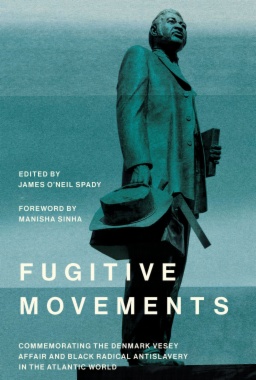In 1822, White authorities in Charleston, South Carolina, learned of plans among the city's enslaved and free Black population to lead an armed antislavery rebellion. Among the leaders was a free Black carpenter named Denmark Vesey. After a brief investigation and what some have considered a dubious trial, Vesey and thirty-five others were convicted of attempted insurrection and hanged.
Although the rebellion never came to fruition, it nonetheless fueled Black antislavery movements in the United States and elsewhere. To this day, activists, politicians, writers, and scholars debate the significance of the conspiracy, how to commemorate it, and the integrity of the archival records it left behind. Fugitive Movements memorializes this attempted liberation movement with new interpretations of the event as well as comparisons to other Black resistance throughout the Atlantic World—including Africa, the Caribbean, and the Northern United States.
This volume situates Denmark Vesey and antislavery rebellion within the current scholarship on abolition that places Black activists at the center of the story. It shows that Black antislavery rebellion in general, and the 1822 uprising by Black Charlestonians in particular, significantly influenced the history of slavery in the Western Hemisphere. The essays collected in this volume explore not only that history, but also the ongoing struggle over the memory of slavery and resistance in the Atlantic World.
Manisha Sinha, James L. and Shirley A. Draper Chair in American History at the University of Connecticut and author of The Slave's Cause: A History of Abolition, provides the foreword.
- Cover�������������������������������
- Fugitive Movements����������������������������������������������������������������������
- Title�������������������������������
- Copyright�������������������������������������������
- Contents����������������������������������������
- LIST OF ILLUSTRATIONS�������������������������������������������������������������������������������
- ACKNOWLEDGMENTS�������������������������������������������������������������
- FOREWORD����������������������������������������
- Introduction����������������������������������������������������
- Part I: Fugitive Direct Action����������������������������������������������������������������������������������������������������������
- Denmark Vesey, South Carolina, and Haiti: Borne, Bound, and Battered by a Common Wind�������������������������������������������������������������������������������������������������������������������������������������������������������������������������������������������������������������������������������������������������������������������������������
- Denmark Vesey and the 1822 Charleston Antislavery Uprising: New Themes and New Methods����������������������������������������������������������������������������������������������������������������������������������������������������������������������������������������������������������������������������������������������������������������������������������
- Writing Reparative Histories of Connection: The 1831 Tortola Slave Conspiracy in the Atlantic World�������������������������������������������������������������������������������������������������������������������������������������������������������������������������������������������������������������������������������������������������������������������������������������������������������������������������
- Black Southwestern Pennsylvanians and the Politics of Free Soil in the Northern Borderlands�������������������������������������������������������������������������������������������������������������������������������������������������������������������������������������������������������������������������������������������������������������������������������������������������
- Fugitivity and Citizenship in the Southeastern Coastal United States: Representing Black Resistance, 1862–1902����������������������������������������������������������������������������������������������������������������������������������������������������������������������������������������������������������������������������������������������������������������������������������������������������������������������������������������������������������
- Part II: Fugitive Memory����������������������������������������������������������������������������������������
- The Silent Jean St. Maló: A Counterhistory of Slavery�������������������������������������������������������������������������������������������������������������������������������������������������������������������������������
- Slavery, Resistance, and Memory in the Lowcountry: The Commemoration of the Stono Rebellion�������������������������������������������������������������������������������������������������������������������������������������������������������������������������������������������������������������������������������������������������������������������������������������������������
- Arrows of Power: The Builsa Feok Festival of Slave Resistance and Abolition in Ghana����������������������������������������������������������������������������������������������������������������������������������������������������������������������������������������������������������������������������������������������������������������������������
- Revisiting Denmark Vesey’s Church�������������������������������������������������������������������������������������������������������������������
- “To See What He Could Do for His Fellow Creatures”: Enslaved Women, Families, and Survivors in North American Slave Conspiracies����������������������������������������������������������������������������������������������������������������������������������������������������������������������������������������������������������������������������������������������������������������������������������������������������������������������������������������������������������������������������������������������������������������
- Freedom Fighter or Attila the Hun? How Black and White Charlestonians Remembered Denmark Vesey, 1822–2014�������������������������������������������������������������������������������������������������������������������������������������������������������������������������������������������������������������������������������������������������������������������������������������������������������������������������������������������
- NOTES�������������������������������
- SELECTED BIBLIOGRAPHY�������������������������������������������������������������������������������
- INDEX�������������������������������
- About the Editor����������������������������������������������������������������

